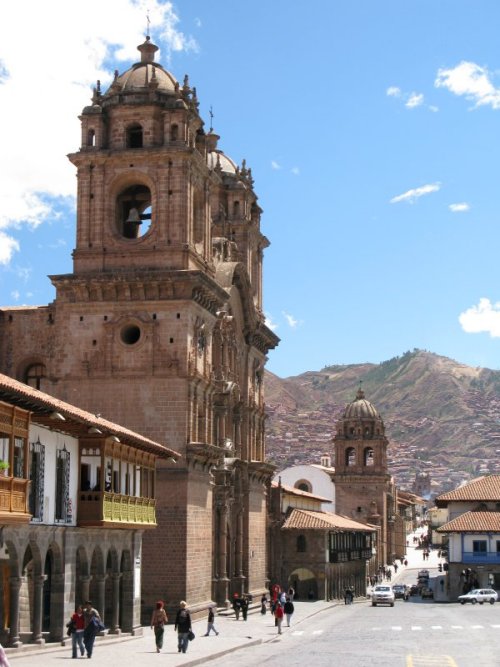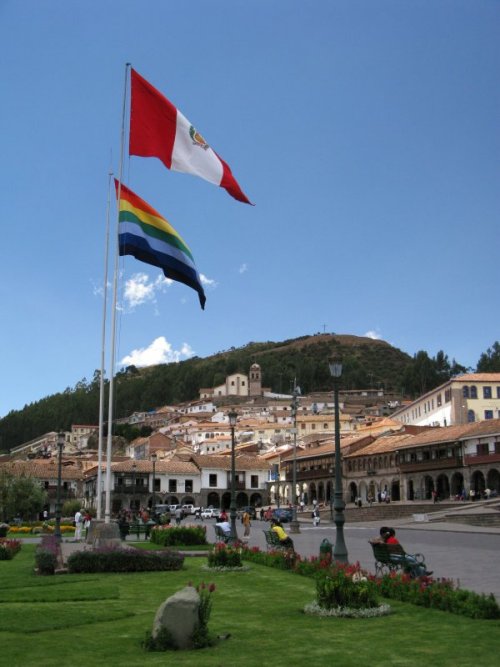Cusco

Cusco was once the main city of the Inca empire, and is now the archaeological capital of the Americas, as well as the continentís oldest continuously inhabited city. The altitude over over 11,000 feet, which can give rise to altitude sickness when flying in from Lima.
I was certainly aware of the high altitude as I felt quite short of breath and by the evening I had a headache, which is not uncommon. Many locals will recommend a cup of coca tea. Coca leaf tea, or Mate de Coca, is a herbal tea made from the coca plant, the same plant that is used to produced cocaine. The amount of cocaine in a cup of coca leaf tea is around 4mg. Coca tea is supposed to increase the amount of oxygen in the blood which is why it is suggested for altitude sickness.
I took a walk towards the Plaza de Armas, where the church of Santo Domingo and the Coricancha temple can be found. The Temple of the Sun at Coricancha was the most sumptuous temple in the Inca Empire. 4,000 priests and their attendants once lived within its confines and the temple also served as the main astronomical observatory for the Incas.
Hundreds of gold panels lined its walls and there were life-size gold figures, solid-gold altars and a huge golden sun disc. The sun disc reflected the sun and bathed the temple in light. During the summer solstice, the sun still shines directly into a niche where only the Inca chieftain was permitted to sit.
Other temples and shrines also existed for the worship of lesser natural gods: the moon, Venus, thunder, lightning, and rainbows. Terraces that face the Temple of the Sun were once filled with life-size gold and silver statues of plants and animals.
The Spaniards looted the temple and emptied it of it's gold. The polished stone walls were used as the foundations of the Dominican Convent of Santo Domingo.
Around the Plaza de Armas you will find a number of people wanting to shine your shoes and pretty girls with baby alpacas that will let you take their photos for a small fee.
Norton Ratís Tavern is a pub just off the plaza (opposite Gato's market) run by a motorcycle enthusiast (Norton is an English motorcycle company). It has great views over the plaza, serves a number of English draught ales, burgers for those that can't face another guinea pig dinner and pub games like darts and pool. Some people get upset that it's not a traditional Peruvian bar with local food, but that's what makes Norton's different.
A number of Incan walls can be found in Cusco. Some of the best areas to see Inca Walls are along the streets of Loreto and Hatunrumiyoc.
Inca walls line both sides of Loreto, which runs southeast from the Plaza de Armas. The south wall is from Amarucancha, site of the Palace of Huayna Capac. On the north side is the wall which belonged to the Acllahuasi and is one of the oldest walls in Cusco.
Hatunrumiyoc runs northeast from the Plaza de Armas. Hatunrumiyoc is famous for the 12 sided stone found along the east wall. Souvenir sellers set up opposite the stone, making it easy to find., although I confess I walked past it without even noticing!
In the Plaza de Armas two flags fly; the red and white Peruvian flag and the rainbow flag of Tahuantinsuyo, representing the four quarters of the Incan empire. The Lonely Planet guide says "Foreigners often mistake the latter for an international gay-pride banner, to which it bears a remarkable resemblance!"

Best Peru Tours placed me in this 'hotel'. Lovely isn't it?

I saw this interesting monument near my hotel in Cusco

The church of Santo Domingo and the Coricancha temple.

The Plaza de Armas in Cusco

The rainbow flag - a symbol of the Inca Empire





